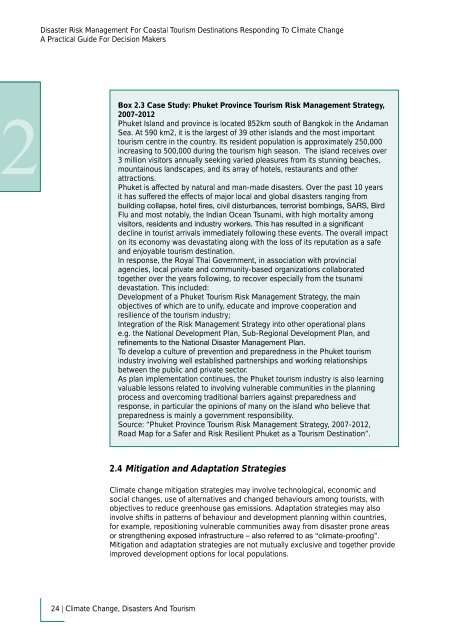Disaster Risk Management For Coastal Tourism Destinations - DTIE
Disaster Risk Management For Coastal Tourism Destinations - DTIE
Disaster Risk Management For Coastal Tourism Destinations - DTIE
You also want an ePaper? Increase the reach of your titles
YUMPU automatically turns print PDFs into web optimized ePapers that Google loves.
<strong>Disaster</strong> <strong>Risk</strong> <strong>Management</strong> <strong>For</strong> <strong>Coastal</strong> <strong>Tourism</strong> <strong>Destinations</strong> Responding To Climate Change<br />
A Practical Guide <strong>For</strong> Decision Makers<br />
Box 2.3 Case Study: Phuket Province <strong>Tourism</strong> <strong>Risk</strong> <strong>Management</strong> Strategy,<br />
2007-2012<br />
Phuket Island and province is located 852km south of Bangkok in the Andaman<br />
Sea. At 590 km2, it is the largest of 39 other islands and the most important<br />
tourism centre in the country. Its resident population is approximately 250,000<br />
increasing to 500,000 during the tourism high season. The island receives over<br />
3 million visitors annually seeking varied pleasures from its stunning beaches,<br />
mountainous landscapes, and its array of hotels, restaurants and other<br />
attractions.<br />
Phuket is affected by natural and man-made disasters. Over the past 10 years<br />
it has suffered the effects of major local and global disasters ranging from<br />
<br />
Flu and most notably, the Indian Ocean Tsunami, with high mortality among<br />
<br />
decline in tourist arrivals immediately following these events. The overall impact<br />
on its economy was devastating along with the loss of its reputation as a safe<br />
and enjoyable tourism destination.<br />
In response, the Royal Thai Government, in association with provincial<br />
agencies, local private and community-based organizations collaborated<br />
together over the years following, to recover especially from the tsunami<br />
devastation. This included:<br />
Development of a Phuket <strong>Tourism</strong> <strong>Risk</strong> <strong>Management</strong> Strategy, the main<br />
objectives of which are to unify, educate and improve cooperation and<br />
resilience of the tourism industry;<br />
Integration of the <strong>Risk</strong> <strong>Management</strong> Strategy into other operational plans<br />
e.g. the National Development Plan, Sub-Regional Development Plan, and<br />
<br />
To develop a culture of prevention and preparedness in the Phuket tourism<br />
industry involving well established partnerships and working relationships<br />
between the public and private sector.<br />
As plan implementation continues, the Phuket tourism industry is also learning<br />
valuable lessons related to involving vulnerable communities in the planning<br />
process and overcoming traditional barriers against preparedness and<br />
response, in particular the opinions of many on the island who believe that<br />
preparedness is mainly a government responsibility.<br />
Source: “Phuket Province <strong>Tourism</strong> <strong>Risk</strong> <strong>Management</strong> Strategy, 2007-2012,<br />
Road Map for a Safer and <strong>Risk</strong> Resilient Phuket as a <strong>Tourism</strong> Destination”.<br />
2.4<br />
Mitigation and Adaptation Strategies<br />
Climate change mitigation strategies may involve technological, economic and<br />
social changes, use of alternatives and changed behaviours among tourists, with<br />
objectives to reduce greenhouse gas emissions. Adaptation strategies may also<br />
involve shifts in patterns of behaviour and development planning within countries,<br />
for example, repositioning vulnerable communities away from disaster prone areas<br />
<br />
Mitigation and adaptation strategies are not mutually exclusive and together provide<br />
improved development options for local populations.<br />
24 | Climate Change, <strong>Disaster</strong>s And <strong>Tourism</strong>

















